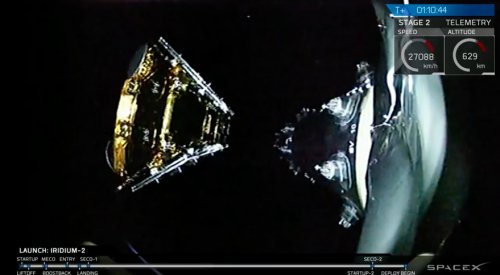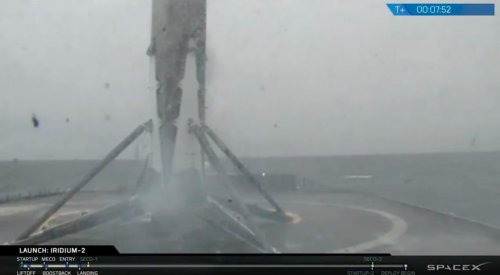Updated 6:05 p.m. Eastern.
WASHINGTON — SpaceX completed a “doubleheader” of launches June 25 with the launch of a second set of next-generation Iridium satellites from California, two days after another Falcon 9 from the East Coast.
The SpaceX Falcon 9 lifted off in foggy conditions from Vandenberg Air Force Base in California at 4:25 p.m. Eastern. The initial phases of the launch went as planned, with the second stage entering low Earth orbit for a coast phase prior to a second burn and then spacecraft separation. All 10 satellites separated as planned during a 15-minute period that concluded one hour and 12 minutes after liftoff.
The rocket’s first stage made a landing on a drone ship in the Pacific Ocean, touching down as planned despite concerns that conditions were “marginal” for the landing because of winds. This was the ninth consecutive flight with a successful landing, on a drone ship or on land, for launches where the company attempted a landing.
The launch is the second in a little more than 48 hours for SpaceX. On June 23, a Falcon 9 launched the BulgariaSat-1 satellite from the Kennedy Space Center in Florida, using a first stage that previously launched the first batch of Iridium Next satellites in January. That stage made a hard, but successful, landing on a ship in the Atlantic Ocean.
The launch is the first to feature the use of new grid fins on the rocket’s first stage, which steer the stage towards its landing site. Previous rockets used aluminum fins, while this vehicle has larger fins made of titanium.
“Flying with larger & significantly upgraded hypersonic grid fins,” SpaceX Chief Executive Elon Musk tweeted June 24. “Can take reentry heat with no shielding.”
The aluminum fins suffered wear and tear during the reentries, which Musk said will no longer be an issue with the titanium ones. The new fins, he said, are “slightly heavier than shielded aluminum, but [have] more control authority and can be reused indefinitely with no touch ups.”
The larger fins, he added, are better suited for the company’s larger Falcon Heavy rocket, whose first flight is planned for later this year, and also allows the first stage to land in stronger winds.
The rocket placed into orbit the second set of 10 Iridium Next satellites for Iridium. Six more launches are scheduled over the next 12 months to place the remaining Iridium Next satellites into orbit.
“Right now, it’s two down with six more launches to go,” Iridium Chief Executive Matt Desch said in a post-launch statement. “Our operations team is eagerly awaiting this new batch of satellites and is ready to begin the testing and validation process.” Those satellites will be “slot swapped” into the operational constellation, replacing existing spacecraft, after several weeks of on-orbit tests and maneuvers.
While this launch used a new Falcon 9 first stage, Desch said in a call with reporters June 19 that he would be open to launching some of the later missions on previously-flown Falcon 9 first stages, if the use of that hardware could accelerate his launch schedule.
- Iridium open to reused Falcon 9s if it means SpaceX can speed up schedule
- SpaceX demonstrates rocket reusability with SES-10 launch and booster landing
- SpaceX to launch Falcon Heavy with two “flight-proven” boosters this year
- SpaceX’s low cost won GPS 3 launch, Air Force says
- SpaceX ready for first launch from historic KSC pad
Share with your friends


(0) Comments
This article comments are currently no :(